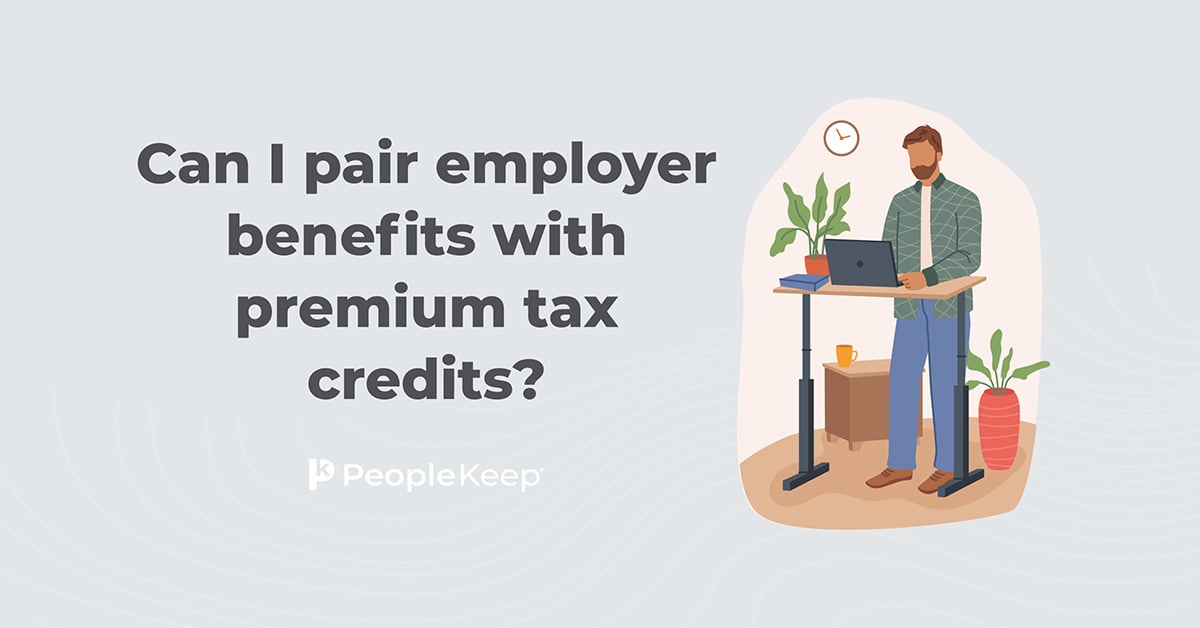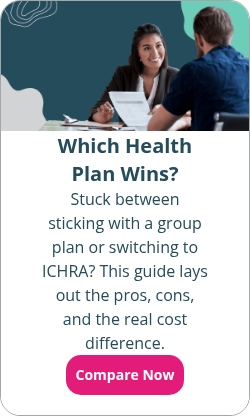How does the employer mandate apply to controlled groups?
By Elizabeth Walker on March 14, 2025 at 3:55 PM
The Affordable Care Act's employer mandate requires applicable large employers (ALEs) to offer their employees affordable health insurance that provides minimum essential coverage and minimum value. If they don’t, they could be subject to federal tax penalties.
Knowing if you’re an ALE isn’t always straightforward. Most businesses just need to determine if they have 50 or more full-time equivalent employees (FTEs). But, this can be complex if several employers have common ownership between companies. For these groups, specific IRS regulations determine whether they must offer health insurance to their workers.
Understanding controlled group rules is essential for ensuring compliance with the mandate. You should work with a tax professional or legal counsel for specific guidance about your ACA obligations. But to help you get started, the article below will cover the basic controlled group rules for ALEs.
In this blog post, you’ll learn:
- What a controlled group is, and how the IRS defines different types
- How controlled groups must calculate full-time equivalent employees (FTEs).
- How an individual coverage health reimbursement arrangement (ICHRA) can help controlled groups follow the employer mandate
What is a controlled group?
A controlled group is two or more businesses connected through indirect or direct common ownership1. Because the companies in the group have a common link, the IRS treats them as one single entity for tax purposes.
Any single organization with common ownership can be a member of a controlled group, including:
- Corporations
- Partnership
- Sole proprietorship
- Limited liability company (LLC)
According to the employer shared responsibility rules, a controlled group must calculate whether it’s an ALE. An ALE is an employer with 50 or more FTEs. If it is, it must offer affordable health insurance to at least 95% of its full-time employees and their dependents. It also must follow specific reporting requirements. The ACA created these special rules to prevent employers from creating many small businesses to avoid mandate regulations.
What are the three types of controlled groups?
The IRS has three classifications for controlled groups2. We'll briefly review each type below to help you determine if your organization is one of these groups.
1. Parent-subsidiary controlled group
A parent-subsidiary group is one or more organizations. These businesses are connected to a common parent company through stock ownership.
A parent-subsidiary group exists if both the following occur:
- One or more businesses in the group have 80% stock ownership of each individual business (except the parent corporation), AND
- The parent company owns 80% of at least one other company (the subsidiary).
For example, let’s say Company A owns 90% of Company B, and 81% of Company C. Since Company A owns at least 80% of each, this relationship is a parent-subsidiary group. For tax and benefit purposes, the IRS treats all three entities as one employer.
2. Brother-sister controlled group
A brother-sister group is a group of two or more companies. Five or fewer common ownership businesses must directly or indirectly have a controlling interest in each group and have effective common control. In this case, the owner must be an individual, a trust, or an estate.
You must satisfy both aspects of brother-sister groups:
- To have a controlling interest, five or fewer common owners must collectively own at least 80% of the stock of each business (if the owner has stock in each company).
- Effective control means the same common owners have over 50% of each business's voting stock. But, stock ownership is only to the extent that an individual has the same level of ownership interest in each of the group’s organizations. You’ll only count the lowest percentage the owners have in each company.
For example, suppose owner A owns 65% of Company A and 50% of Company B. Owner B owns 30% of Company A and 30% of Company B. Both owners collectively control at least 80% of both organizations, which satisfies the first test.
Let’s assume all owned stock is voting stock. Since owner A owns fewer shares of Company B than Company A, we’ll use that percentage for the next test. For owner B, these amounts are the same for each company. We’ll add the 50% ownership for owner A and the 30% ownership for owner B to get 80%, which satisfies the 50% rule.
3. Combined controlled group
A combined group is a combination of a parent-subsidiary and brother-sister group.
A combined group is a group consisting of three or more organizations where:
- Each business entity is a member of either a parent-subsidiary or brother-sister group.
- At least one company is the common parent of a parent-subsidiary controlled group. The company must also be a brother-sister group member.
Controlled group determinations generally follow IRC §414(b) and §414(c). If you own a partnership or LLC, you’ll use ownership/voting rights instead of stock.
How can controlled groups calculate their full-time equivalent employees?
The IRS requires businesses within a controlled group to combine as a single employer to determine whether they’re an ALE.
Here’s how it works:
- Under the ACA shared responsibility rule, if the aggregate total of FTEs in a controlled group is at least 50, each business within the group is subject to the employer mandate. This is the case even if an individual company doesn’t have 50 or more FTEs.
- If the combined total of FTEs is less than 50, the controlled group isn’t an ALE. So, individual businesses aren’t required to offer their employees health insurance. They won’t be subject to a penalty for not doing so.
If the controlled group fails to determine whether it’s subject to the mandate correctly, it may have to pay significant penalties. Even though the controlled group’s FTE count is an aggregate number, the IRS will assess each group member in violation individually3. So, controlled groups must carefully calculate their ALE status to avoid potential violations.
Does the employer mandate affect controlled groups with parent companies outside the U.S.?
The employer mandate regulations for business owners functioning on a controlled group basis apply regardless of whether the parent or owner is in the U.S. For example, a foreign corporation with U.S. subsidiaries must aggregate the employees of the parent company and all subsidiaries who work in the U.S. to comply with the employer mandate.
This can be tricky for foreign-owned subsidiaries in other businesses that might not know the existence of the U.S. companies. However, individual employers are responsible for knowing their employer mandate obligations. If they don’t, their group may receive non-compliance penalties.
However, only U.S.-based employees count when determining FTEs. Foreign employees don’t count toward the FTE numbers.
How an ICHRA can help controlled groups satisfy the employer mandate
If you’re subject to the employer mandate, finding a compliant health benefit can be challenging. While group health insurance is the traditional option, it can offer limited plan options and be expensive. Thankfully, ALEs can satisfy the employer mandate with an affordable and customizable individual coverage health reimbursement arrangement (ICHRA).
With an ICHRA, you choose a monthly allowance to offer your employees. The ICHRA has no minimum or maximum allowance limits. So, it can work for every employer’s budget. Then, your eligible employees buy a qualified individual health plan and other out-of-pocket medical items. Once you approve the expense, you reimburse them tax-free up to their allowance amount.
As mentioned above, ALEs must offer affordable health insurance that provides minimum essential coverage (MEC) and meets minimum value standards to at least 95% of their full-time employees and their dependents.
In 2026, an employer’s ICHRA is affordable if employees aren’t paying more than 9.96% of their household income for the lowest-cost silver plan. If you’re using the federal poverty line safe harbor, this means your employees shouldn’t pay more than $$129.89 per month for their self-only health plan coverage after factoring in their ICHRA allowance.
ICHRA affordability calculations always use the lowest-cost silver plan. Luckily, silver plans exceed the minimum value threshold, so the ICHRA already fulfills that mandate rule. So, if your affordability calculations are correct when choosing your allowance, your ICHRA will satisfy the mandate.
ALEs offering an ICHRA must also fulfill specific reporting requirements under the ACA. Work with a tax professional or accountant to ensure you fill out your tax forms correctly.
Conclusion
If you’re trying to avoid the employer mandate by dividing your business into smaller, separate companies, you could be in trouble. Depending on your organization’s combined size, you may still be subject to the mandate. It’s essential to calculate your entire group’s FTE count so you can choose the right health plan and avoid costly penalties.
By offering an ICHRA, your employees can have more control over their healthcare choices. If you want to offer an ICHRA as a small business, PeopleKeep by Remodel Health can help! Our user-friendly HRA administration software helps you create a customized health benefit that will satisfy the employer mandate without the headache.
If you’re an ALE looking for more hands-on and personalized service as you transition away from group coverage, Remodel Health’s ICHRA+ has everything you need to easily navigate your employee benefit.
This article was originally published on December 10, 2020. It was last updated on March 14, 2025.
1. Internal Revenue Code §414(c)
Check out more resources
See these related articles

What is an ICHRA?
What is an ICHRA, and how does it work? Find out everything you need to know about this innovative healthcare option: the individual coverage HRA.

What is the family glitch, and is it fixed?
Curious about the Family Glitch and its impact on your healthcare coverage? Find out everything you need to know.

Can I pair employer benefits with premium tax credits?
Discover if you can combine employer benefits with premium tax credits when it comes to health insurance. Get all the answers in this informative post.



